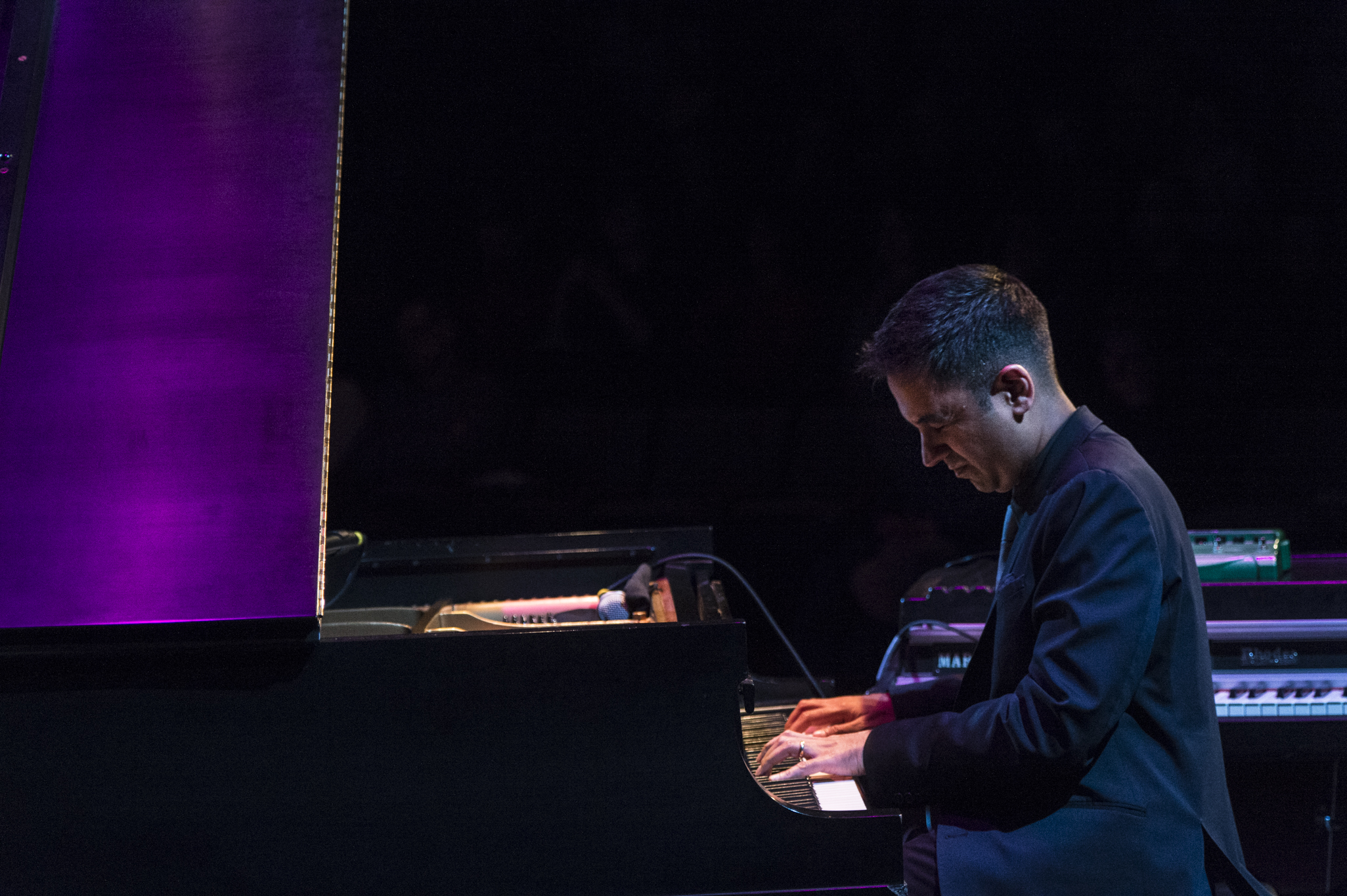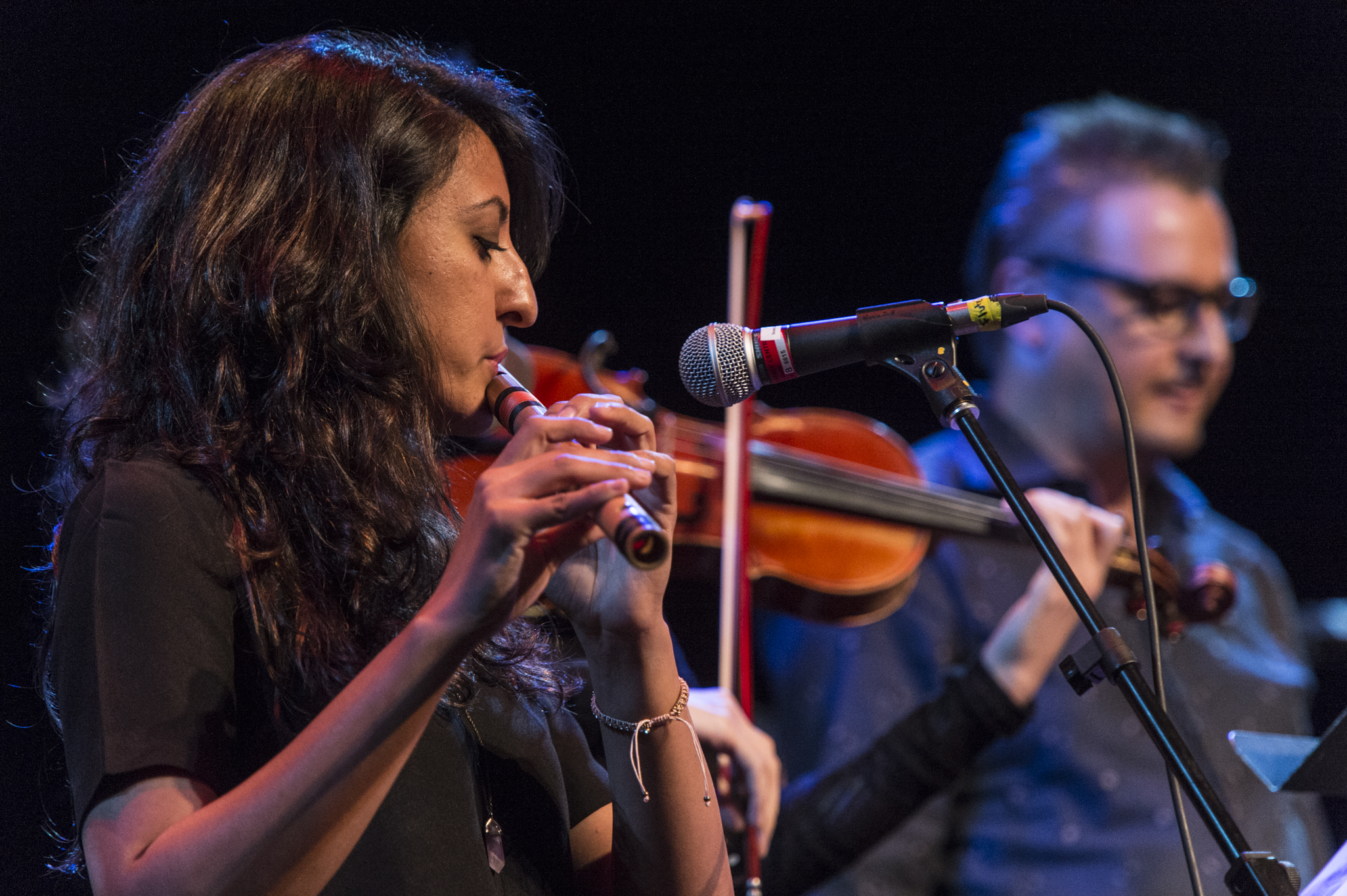Banff's Jazz Workshop Is a Party and Vijay Iyer Is the Ultimate Host

We caught up with artistic director of the Banff International Workshop for Jazz and Creative Music, Vijay Iyer, to learn how he picks participants, his priorities for the popular program, and why it's like hosting a party. Don't miss your chance to see Vijay and the participants live. Get your tickets for upcoming events like Tyshawn Sorey’s Conduction and the program's final International Jazz and Creative Music Ensemble Showcase performance, on sale later in 2019.
For three weeks every summer, Banff Centre's campus comes alive with jazz music. Between almost nightly shows at The Club, the late-night jams that fill the space between clinking beer glasses at Maclab Bistro, and weekend performances in the Margaret Greenham Theatre, it’s hard not to feel the infectious vibe that takes over.
“Do I sleep? A little bit,” says Vijay Iyer, the Artistic Director of the Banff International Workshop for Jazz and Creative Music. The jazz pianist, Harvard professor, and MacArthur Fellow, who has more than 20 records to his name as leader, is in his seventh year as the head of the program now in 2019, a position he says is much “like throwing a good party.”
And like any good party, half of the battle is deciding who to invite. With a new group of guest faculty every week for three weeks, not to mention selecting the 50 musicians who will participate, Iyer has his job cut out for him before anyone arrives at Banff Centre.
“I just sit with a big pile of potential candidates and try to imagine the community that will emerge from it.
“I spend a lot of time thinking about whom to put with whom when I put an ensemble together,” he says. “It’s almost like this divination process for me. I really try to get a sense of each person and try to hear into the future: how might this work together? What do they need from each other?”
Iyer first came to Banff Centre in 2005 as one of the guest faculty members for the workshop when jazz trumpeter and composer Dave Douglas was the artistic director. He admires the work Douglas did, and still uses the three-week structure he created. But when he took over in 2012, Iyer knew where his focus would lie.
“When they interviewed me several years later for this job, I put front and centre the first three priorities: diversity, diversity, diversity.”
One stand-out musician, Rasika Shekar, came to the workshop a few years ago in 2016 with a background in Carnatic music, a type of South Indian classical music, and plays with a series of flutes, including one made of bamboo. Iyer says he’s continually surprised not only by her masterful playing of the complex system of flutes, but how she is able to translate her work into collaborations that are easy for musicians unfamiliar with Carnatic music to follow.
“You look at this combination of people, [Shekar] and a violinist from Lebanon, a vibraphone, guitar, piano, trumpet and bass, and think ‘That’s not going to work.’ But from the first sound, it was working,” says Iyer. “They were very in the zone and serious about making it work, and they found a way. I was sitting with some of the other faculty and they were amazed. Afterwards Ben Williams, the bass player, said, ‘What the hell were they doing? It was killing, but what were they doing?’ I think it really left an impression, because it kind of sent the message that there’s more to discover.”
This kind of revelation is not hard to come by when you listen to the performances the ensembles put on around the Centre. Both faculty members and the musicians participating are constantly learning from one another. As Iyer observes, “music is a continuum.”

Musician Rasika Shekar playing a bamboo Carnatic flute at Saturday Night Jazz in the Margaret Greenham Theatre.
For Iyer, that makes it all the more important that he use his role to “make sure that what’s happening here authentically reflects what’s happening in the world.” He tries to reflect that in the faculty as well, whether it be through a mix of age, or of gender, race and class.
“Not in the sense of some kind of one-world-global-village kind of thing, but just the premise that anybody can make music together if they just spend the time, and decide to listen to each other, and form a community together.”
Make no mistake, as much as the Banff International Workshop for Jazz and Creative Music is like a party, the mornings are just as early as the nights are late — a lot of work goes into the time musicians spend here.
Most musicians apply to the workshop as improvisers, but everybody composes, says Iyer. People can be intimidated by composing, but the distinction, if there is one at all, is moot. “You can compose a salad,” Iyer says with a laugh.
“Composing is just putting things together with other things. The word ‘improvised,’ improvisée, just means ‘unforeseen.’ Both involve structure, memory, and agency. The only difference between the two is that composing involves events in the future, while improvising deals primarily with the present. We’re all doing both, whether you acknowledge it or not.”
Banff provides a different kind of learning environment, less academic and more face-to-face, where musicians have the opportunity to learn and create with each other directly. “I sort of see being here as the antidote to being at Harvard,” says Iyer, who’s been a professor in the Department of Music at the university since 2014.
Besides Iyer, the faculty is made up of hand-picked musicians with a wide range of instruments at their sides, including famed composer-performer Tyshawn Sorey (Co-Artistic Director of the Jazz program).
Surrounded by such phenomenal musicians, both on the faculty and participant sides, it’s clear that Iyer has selected the ultimate invitation list.
“I just try to receive and channel the brilliance around me, and try to learn from it, and try to be a good host.”
In fact, when asked, that’s how Iyer chooses to describe himself. At a recent New Year’s party, a friend was trying to describe Iyer as he introduced him to a guest.
“He kept fumbling because he didn’t really know how to encapsulate me, so he asked me to describe myself. They were among the first guests to arrive to the party, so I said, ‘If you stay here for the next few hours, you will know who I am, because you’ll meet everybody in my life.’ And that’s basically what happened. On her way out, she gave me a big hug.”
In the seven years since he became the artistic director of the workshop, Iyer has had alums approach him time and time again, asking if they can reapply to the program and return to Banff Centre under his guidance.
“People really cherish the time they have here and become really nostalgic for it,” says Iyer. “And usually I tell them, ‘You need to let other people have this opportunity that you had. It’s time for you to carry it forward.’”